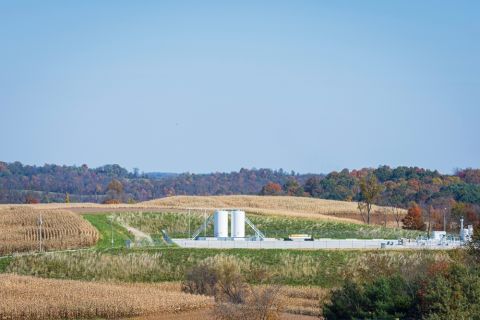However uncomfortable high gasoline prices may be for consumers, they are not high enough for the 80% of refiners that have to pay the world price for crude oil based on Brent rather than on the previously accepted West Texas Intermediate (WTI) benchmark. High Brent prices have unfortunately been met with relatively low oil product prices in recent years, and have squeezed refiners' profit margins to the point that several have had to close operations.
Normally, this would lead to an upward correction in retail prices relative to crude oil, but instead it appears to be creating more opportunities for midstream companies to bridge gaps both in crude oil and product supplies, thus giving them stability and pricing power.
Root cause
The cause of this is generally geographical and lies with pricing mechanisms of crude oil which have been developing since 2007. Cushing, Oklahoma, is the delivery point for the NYMEX WTI futures contract. Inventories in storage tanks located there were already growing steadily in 2006.

In 2007, a fire broke out at Valero Corp.'s McKee refinery in Sunray, Texas, which drew oil from Cushing. The fire caused inventories to build to a record of 28 million barrels (bbl.). As a result, pricing differences between Brent North Sea crude and NYMEX WTI increased to more than $6 per bbl.
Inventories at Cushing were drawn down during the oil price rally of 2008, but were built up again after the price bubble popped and financial markets collapsed in September 2008. They continued to build after 2008 due to higher production in the Bakken oil shale and Canadian oil sands, with a new record near 42 million bbl. set in April 2011.
Brent oil prices have remained much higher than those of WTI since mid-2010 and have averaged $15.80 per bbl. above WTI since the start of 2011. In addition to the high inventory levels at Cushing, pushing down WTI, aging oil fields and production declines in the North Sea have pushed up the price of Brent.
Energy-reporting company Platts determines which streams of North Sea crude make up its pricing formulation, and it has had to add new streams to the grade in the past as North Sea production has declined, in order to keep it a viable benchmark. It also did this in 2002, when it added Forties and Oseberg to the Brent contract and again in 2007 when it added Ekofisk.
The problem now is that production has fallen so sharply once again that it may be a factor in higher prices. Output deliverable against the contract was 1.9 million bbl. per day in 2004, but has fallen to just below 1 million bbl. per day currently. This 45% decline compares to a global production gain of 8.5% during the same period, which incidentally matches gains in global demand.
The cheaper price of crude inputs in the Midwest U.S. has been a boon to refineries there, such as those owned by Valero, HollyFrontier Corp., Marathon Petroleum Corp., and Coffeyville Refining Corp., where capacity has grown and utilization rates have risen.
The Midwest Petroleum Administration for Defense District (PADD) 2 has seen refinery throughput increase by 127,000 bbl. per day in 2011 to 3.39 million bbl. per day compared to 2007 levels. On the Atlantic and Pacific coastal regions, PADD 1 and 5 throughput has fallen by 403,000 bbl. per day and 139,000 bbl. per day, respectively.

Areas of the country where oil input prices are based on Brent have seen margins squeezed and operations shuttered. A recent Energy Information Administration study showed that utilization rates in PADD 1 have fallen to 68% in 2011 from 93% in 2005, while PADD 5 has fallen to 82% from 92%. Meanwhile, rates in the Midwest PADD 2 have been fairly steady at 91% in 2011 compared to 93% in 2005.
The NYMEX WTI contract has been criticized because its Cushing delivery point is more than 500 miles from the refinery centers on the Gulf Coast of Texas, and because it is considered to be landlocked. Inventories have grown considerably as refineries in the Midwest have received more crude oil from the Bakken region and from Canada. The contract has frequently traded in a backwardated futures price structure, which has also made it favorable to index funds. The price of WTI fell to around $20 per bbl. below Brent in early-2012, while Bakken oil is priced more than $30 per bbl. below Brent.
Given the large price differential and lack of pipeline capacity to deliver Bakken and Canadian oil to the Gulf Coast, rail shipments between the two regions have increased to 300,000 bbl. per day this year from nil a few years ago. It costs around $7 per bbl. to ship oil from Bakken shale fields to the Gulf Coast, with pipelines expected to reduce that cost to around $1 per bbl.
Oneok Partners LP plans to build a pipeline from the Bakken to Cushing, which will open in 2015. There was no rail infrastructure to deliver Cushing oil to the Gulf Coast until the Seaway pipeline, already in place, was reversed to flow south. The decision to change its direction was made when Enterprise Products Partners LP and Enbridge Inc. bought the pipeline from ConocoPhillips in October 2011. The two companies have since asked the Federal Energy Regulatory Commission for approval to adjust tariffs without regulatory approval, showing the pricing power they will enjoy.
Gulf Coast refineries will likely be tolerant of anything that reduces their input costs, but have had to reduce operations instead. In addition to selling its interest in the Seaway Pipeline, ConocoPhillips is spinning off its refinery business and selling its 185,000 bbl. per day refinery in Trainer, Pennsylvania. Sunoco Inc. and Hovensa LLC also closed operations in Marcus Hook, Pennsylvania, and the U.S.V.I., respectively, and have closed capacity of 713,000 bbl. per day.
Refineries on the East Coast generally receive 95% of their oil inputs via imports rather than from domestically produced crude oil. As a result, they have to pay the world price for crude oil, which is based on the Brent benchmark. That's resulted in refinery margins of $8 to $9 per bbl. since 2009 using spot 3-2-1 ratios, and much less than profit margins earned in 2007 and 2008.
The bigger difference is that the cost of oil inputs is nearly double that of earlier years, so profit percentages have fallen to 7% to 8% for East Coast refiners, compared to nearly 19% in 2007. Profit margins have fallen as low as 1.3% at times, reaching the lowest in nine years.
The profit picture is similar for Gulf Coast refiners, even though they receive about 70% of their feedstock from imports. Margins occasionally are negative, falling to -1.56% at their weakest level this year. Midcontinent refiners have improved their profit picture based on the lower cost of WTI crude oil relative to Brent. Profit margins have not been as good for Midcontinent refiners since 2006 and 2007.

Pipeline companies will have to adapt to the shift in the center of demand for both crude and products that is taking place. Unless crude-oil pipelines are constructed to take oil eastward and alleviate high Brent prices, the center of gravity for refining will shift to the Midwest and Gulf Coast and away from the East Coast.
Product pipelines will be the answer again, where the Colonial Pipeline is already responding by adding capacity. The capacity of the pipeline is scheduled to rise by 125,000 bbl. per day and reach 950,000 bbl. per day by 2014.
Additional capacity will be needed, as the Colonial's expansion falls short of the 713,000 bbl. per day of refining capacity that has been lost already. Colonial has also been oversubscribed since August 2011.
Furthermore, there are needs for refined fuels on the East Coast that will have to be made up with waterborne shipments, which will be subject to the capacity constraints of the Jones Act if the fuel is produced in the U.S. Imports will have to make up for some losses, but may be in short supply after the closures of several Petroplus Holdings AG refineries in Europe early this year.
Pipeline equities have been rebounding since before the broader stock market rebound started in March 2009. Enbridge bottomed in November 2008, along with many other pipeline names, and their stocks have doubled or tripled in the three years since.
Even on a shorter-term basis, the first-quarter rally in the broader stock market was preceded for two months by pipeline companies. Bloomberg reports that pipeline companies are valued at an average of eight times EBITDA, compared to 2.7 times for refiners.
Enbridge, Enterprise Products Partners, Kinder Morgan Inc., Plains All American LP, and Magellan Midstream Partners LP should be winners of this geographic shift and have outperformed refinery names like Valero.
Developments in the pipeline industry should also have an impact in the futures markets, where the Brent-WTI spread could contract as WTI becomes less landlocked. The WTI futures price structure has been in contango since late 2011 as inventories have backed up at Cushing. The contango is in place through January 2013 futures and turns to backwardation due to the startup of the Seaway pipeline.
The backwardation should become steeper as the Seaway comes online. The function of markets is to expose opportunity for companies and investors. The year 2012 appears to be holding to that idea.
Tom Pawlicki is the director of commodity research for EOX Holdings, a wholly owned subsidiary of independent interdealer broker OTC Global Holdings, which manages the EOXLive web-based platform that takes traditional voice broking and merges it with an interactive electronic trading environment to facilitate price discovery and provide trade execution services.
Recommended Reading
Analyst: Chevron Duvernay Shale Assets May Sell in $900MM Range
2024-01-29 - E&Ps are turning north toward Canadian shale plays as Lower 48 M&A opportunities shrink, and Chevron aims to monetize its footprint in Alberta’s Duvernay play.
Athabasca Oil, Cenovus Energy Close Deal Creating Duvernay Pureplay
2024-02-08 - Athabasca Oil and Cenovus Energy plan to ramp up production from about 2,000 boe/d to 6,000 boe/d by 2025.
Analysts: Why Are Investors Snapping Up Gulfport Energy Stock?
2024-02-29 - Shares for Oklahoma City-based Gulfport Energy massively outperformed market peers over the past year—and analysts think the natural gas-weighted name has even more upside.
Uinta Basin's XCL Seeks FTC OK to Buy Altamont Energy
2024-03-07 - XCL Resources is seeking approval from the Federal Trade Commission to acquire fellow Utah producer Altamont Energy LLC.
SilverBow Saga: Investor Urges E&P to Take Kimmeridge Deal
2024-03-21 - Kimmeridge’s proposal to combine Eagle Ford players Kimmeridge Texas Gas (KTG) and SilverBow Resources is gaining support from another large investor.





